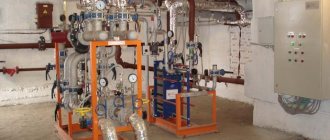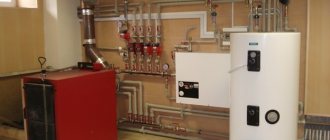Almost everywhere, natural gas is the cheapest energy source for heating a home. And if it is not possible to bring a pipe to the cottage, gas workers offer an option in the form of LPG. At first glance, gas heating with a gas holder looks like a good alternative, doesn’t it? Autonomous gasification guarantees independence and does not require approvals and lengthy obtaining specifications. However, everything has pitfalls.
We have studied all the pros and cons of liquefied petroleum fuel and will tell you how good it really is. The research we conducted will definitely help you decide exactly whether it is worth installing gas holder equipment on your site.
Operating principle of the gas holder
Owners of a country house or country house who have chosen gas supply using a gas holder should know that it is not just a tank, but a high-tech installation in which gas is not only stored, but also goes through several stages of processing.
Installation of a gas supply system for a private house with a gas holder
The principle of operation resembles the operation of tanks with the help of which condensed steam is collected. The main stages of the workflow are as follows:
- Gas under high pressure (up to 1.8 MPa) is pumped into a gas storage facility for a country house.
- When heated, liquefied fuel turns into a gaseous state.
- The reactor creates a pressure suitable for gas to enter the heating system supply line.
Most often, it is recommended to install a gas tank in a country house or in a private house located at a distance from the centralized heat and gas supply. The tanks are available in different sizes, which makes it possible to serve buildings of different sizes - from several tens to hundreds of square meters.
There may be several combined containers
The maximum area of the house that a commercially produced gas tank can provide with heat is 5000 square meters. m. Such an installation is enough, for example, for a holiday home of quite respectable size. And for smaller residential buildings, finding a gas storage facility is not a problem.
Convector heating
This method of heating country houses with gas cannot be called too widespread. But sometimes convectors, including gas ones, are still used to heat private residential buildings. Such systems operate based on a simple law of physics. Heated air, as you know, rises upward, and cooled air sinks down.
The advantages of convector heating primarily include:
- no negative impact on the air (oxygen is not burned);
- no effect on air humidity;
- economical, easy to install.
The disadvantages of this type of heating are:
- feeling of “overheating” of the air;
- high temperature difference at the bottom and top of the room;
- low efficiency in high rooms.
The main heating equipment in such systems used for heating private houses with gas is a convector running on blue fuel. The air is heated as it passes through the heat exchanger of this device and enters the premises.
Pros and cons of using
Using a gas holder for autonomous heating provides the owner of a country home with the following advantages:
- allows you to use the basic benefits of civilization even at a great distance from populated areas - heating and water heating;
- reasonable heating cost;
- environmental friendliness - no emissions of harmful substances characteristic of solid fuel and liquid fuel heating;
- safety - by observing the requirements of regulatory documents and rules when installing a gas tank in a private house, the risk of spontaneous combustion during operation is reduced to zero.
Maintenance of the gas tank and pipelines does not require large expenses; the operational life of the installation exceeds 20 years. So buying and installing a gas tank is a justified investment.
Heating with liquefied gas is a good choice if there is no main gas pipeline
Despite all the advantages, there are disadvantages of a gas tank. The home owner should also be aware of them. The disadvantages include:
- The serious cost of equipment, on which you will have to spend at least 100 thousand rubles. There is an opportunity to save money by buying a used unit, but there is a risk of buying a tank with an almost used up resource, and this means the likelihood of a gas leak and serious repairs, which can cost a considerable amount.
- When filling a gas tank with gas, a substantial amount is required at a time. The desire to save money leads to the purchase of fuel from unverified suppliers, whose gas quality is either not controlled at all or is controlled very rarely.
- Refilling with low-quality gas leads to equipment freezing in winter. The situation is unpleasant, but solvable—it is necessary to heat the gas tank reducer. But, during problems, the heating system may defrost. So it is better to buy liquefied gas only from those suppliers that you can trust.
The disadvantages also include the constant increase in energy prices, which makes you wonder whether a gas tank is profitable in a private home or whether it is worth giving preference to other types of heat supply. On the other hand, heating with gas is still the most cost-effective. The choice - gas tank or electricity - is most often made in favor of the first option.
Device
To put it quite simply, a gas holder is the same well-known gas cylinder, only with a larger capacity and installed for several decades.
The design is as follows - a container made of steel sheets with a thickness of at least 6 mm, painted in several layers of paint with the addition of epoxy resin to increase tightness and strength. The filler neck is located at the top of the tank. The higher it is, the higher the protection of the gas tank from precipitation and freezing. What does the shut-off valve consist of:
- safety valve;
- level gauge (gas fill indicator);
- condensate drain valve;
- filling valve;
- pressure gauge;
- two-stage reducer (allows you to adjust the working pressure).
The gas holder is installed on a concrete slab, onto which it is mounted on reinforced support legs.
It should be noted that when installing a pipeline from the tank to the house, it is recommended to install a condensate collector, which can form in the vapor phase during intensive operation of the boiler.
Classification and types
To choose a suitable gas holder for your home or garden, you should know what types there are, what their advantages and disadvantages are. Liquefied gas storage facilities are usually classified according to three main criteria: by installation method (underground and above-ground type), mobility (stationary and mobile) and material. We’ll talk about these points and some other characteristics further.
When choosing a place to install a gas tank, you must take into account that a refueling vehicle must arrive
Design
By design, gas holders can be horizontal or vertical. Vertical ones take up less area, but the disadvantage of this option is the small evaporation surface area.
A vertical gas holder takes up less area on the site
Because of this, a vertical gas holder for a private home is not used in the northern regions of our country - the productivity is too low at low temperatures. To increase it, you have to heat liquefied gas using electricity, which increases the cost of maintaining the heating system, and also makes heating dependent on the availability of electricity. Power grids in the northern regions cannot boast of stable operation, so in these areas it is better to choose horizontal models.
A large pit is required for a horizontal gas holder
Horizontal type installations require a larger area for installation, but do not have performance problems, so they are used more often than vertical ones. The evaporation area in such gas holders is much larger, and so is the productivity (with equal volume). The operation of such equipment is practically not affected by the ambient temperature - especially if you choose installations with a high neck.
Installation method
Depending on their location on the site, gas tanks can be underground or aboveground. The advantages of installations that are installed below the surface of the earth include:
- minimal fire hazard;
- reducing the area occupied by the installation;
- no need to use heating systems and pumps.
The disadvantages of underground installations are the increased volume of work for their installation (it is necessary to dig a pit) and capital costs - prices for above-ground gas tanks for a country house are noticeably lower. Another disadvantage is more complex maintenance.
Installing a ground-type gas holder does not cause any difficulties - you only need a flat area
If the winters in the region are mild, with slight and short frosts, the ground option is quite suitable. But horizontal or vertical - choose according to needs (performance).
For a significant part of Russia with winter temperatures down to –30°C and below, underground installations are suitable. If desired, you can find above-ground ones with factory insulation that can operate at such low temperatures. But their cost is much higher - precisely due to insulation. In this situation, you need to compare the costs of installing an underground storage facility (pit + slab) and only then choose.
If you decide to install an above-ground gas tank, keep in mind that the tank is large and usually painted in a bright color. It definitely won’t serve as a decoration for the landscape. This consideration must also be taken into account.
Mobile storage
One of the options for a ground-based gas tank is a mobile installation or a gas tank on a trailer. The average volume of such a container is about 600 liters - quite enough for a summer house. It can also be used for a small private house in the following situations:
- if there are not enough gas cylinders to heat the building, but the heated area does not yet require the installation of a large tank;
- the house is expected to be connected to a centralized gas or heat supply in the near future, and the gas holder is only a temporary solution;
Mobile gas holder - a solution for temporary gas supply to a small private country house or for a summer cottage - if necessary, heat the house only temporarily (for example, on weekends);
- if the standards for installing a gas tank at a dacha or a site near a country house do not allow the placement of above-ground or underground stationary equipment.
You can buy or make a mobile gas tank with your own hands for emergency or temporary gas supply. Its peculiarity is the need for a heating system and its relatively low (compared to tanks) cost. Average prices for mobile gas tanks for a country house start from 100 thousand rubles. A used device can be purchased cheaper, but it is not as safe to use. Manufacturing a mobile storage facility yourself requires a certain level of knowledge and experience from the contractor.
Material of manufacture
Gas tanks for servicing summer cottages and private houses are made mainly from steel. The use of plastic is recommended only when installing this container at a large distance (at least 50 m) from a residential building. Nevertheless, you can often hear about plastic gas tanks. Usually we mean a steel container with a polymer coating. This is the optimal solution. The strength of steel (given its proper quality) is beyond doubt, but steel rusts and collapses, and the protective polymer shell prevents this process. From the point of view of longevity, steel gas tanks with a polymer coating are an ideal option.
When choosing, pay attention to the maximum pressure
Special corrosion-resistant steels are chosen as the material for the container. Their cost is higher, but the additional costs are paid off by the high quality of the coating, increased service life, reliability and safety of use. In addition, the use of stainless steel for the manufacture of a gas tank increases the period between inspections (for some models - up to 35 years) and replacement of protective magnesium anodes. These services are paid, so stainless steel products allow you to save on operating costs.
Selecting the gas tank volume
When choosing the size of the installation, you should know that the minimum volume of a serial gas tank is 1000 liters. It is designed for the needs of a private house with an area of 40–50 m² with brick walls. For a similar building with an area of 100 m², a capacity of 2500–3000 liters is required, for 200 m² - 5500 or 6000 liters.
If you need to calculate the volume of a gas tank for heating a brick house, multiply the area of the building in m² by 25 - this is for refilling no more than once a year. Such a tank is refilled from March to September, when the cost of liquefied gas usually decreases.
Do not forget that you will also have to lay a route - pipes for supplying gas to consumers - a boiler, geyser, stove, etc.
If the walls of the building are not brick, you can calculate the volume of the gas tank by knowing what the gas consumption for a certain period will be for the selected autonomous gas supply of a private house. If there is no such data, compare the thermal conductivity of brick walls and the walls of your house. And based on the comparison results, you increase or decrease the volume of the container.
Calculation example
An example is the calculation of a gas holder for a 200 m² house with brick walls. It is assumed that during the heating season (about six months), on average, about 25 liters of liquefied gas are burned per square meter of heated area. For a house of 200 m² during this period, 25 liters * 200 m² = 5000 liters are consumed. This will be the required volume of the gas tank for this house.
You can roughly calculate the volume of a gas tank based on the size of the house and the material of the external walls.
The calculated volume may change if there are other gas consumers in the house besides the heating system - for example, a water heater or a gas stove. They “pull” very little gas, so you can add 15-20% of the resulting figure.
Boiler power calculation
There is another method for determining the volume of a gas tank, based on the power of the heating boiler. It is usually accepted that the boiler should operate at approximately half its power or half the time. In this case, during the coldest period it will cope with heating without any problems. In addition, this approach extends the life of the boiler (it does not operate at maximum power, so it wears out more slowly). Therefore, gas consumption is considered to be 50% of the boiler power.
Calculation example. The boiler is 22 kW. To calculate, we take half the power - it is necessary that the fuel produces 11 kW of heat. When burning one liter of liquefied gas, we get 12.5 kW of heat (reference data, if you know what gas you will use, take the calorific value of your fuel). The following is the calculation:
- To obtain 11 kW you will need 11 kW: 12.5 kW/liter = 0.88 liters . This is the volume of gas required to operate the boiler for an hour.
- To find out the daily volume, multiply by 24 hours: 0.88 l * 24 hours = 21.12 liters/day .
- Monthly consumption - multiply the resulting figure by 30 days. 21.12 l/day * 30 days = 720 liters/month .
You can more accurately calculate the volume of a gas tank based on the power of the heating boiler.
Next, calculating the volume of a gas tank for a private house is not difficult - count the number of months in the heating period and multiply. It is also worth making adjustments depending on the efficiency of the boiler. For new boilers this is not critical, but for old boilers the addition can be very significant. For example, if the boiler efficiency is 88%, you need to add 12% of the calculated volume.
Calculation of tank volume
As a rule, the volume of a gas tank is calculated by specialists who deal with autonomous gas supply systems for houses. However, you can make the necessary calculations yourself.
It is important that the dimensions of the container have a margin, since its useful filling should not exceed 85% of the total dimensions. The remaining volume is filled after gas expansion.
The following indicators influence the calculation of tank volume:
- total heated area of the house;
- number of people living;
- heating system power;
- level of insulation;
- average annual temperature.
The frequency of refills depends on the size of the tank. If you use gas equipment all year round, you will need at least two refills. The composition of the gas mixture for winter and summer contains different proportions of butane and propane.
Most of the gas mixture is spent on heating. When calculating heating, it is taken per 1 sq. m area of 30 liters of gas mixture. Based on this, for a house of 100 sq. m will need a gas storage of 3.0 cubic meters. m.
Rules for placing gas tanks
The installation location of the gas holder depends on its volume, the area of the heated home, gas consumption and customer preferences regarding the microclimatic conditions in the premises. Sanitary rules and regulations (SanPiN) provide for the following distance from the gas tank to a residential building:
- for above-ground tanks up to 5 cubic meters - 20 m;
- for those located underground at 5–10 cubic meters. m – up to 30 m;
- for above-ground storage facilities for 10,000–20,000 liters – 40 m;
- for underground gas tanks with a capacity of 10–50 m³ – from 10 to 20 m.
Despite the fact that sanitary rules and regulations require the location of gas storage no closer than 10 m from the building, sometimes they are placed at a distance of 5 meters - this should not be allowed. For mobile installations, the minimum distance from the house to the gas tank is practically not regulated. Mobile equipment can be installed directly against the wall of a heated room.
Don’t forget about the need to organize convenient access for the refueler
There are rules for the placement of storage facilities depending on the climate, and for how to install a gas holder with high groundwater. The top of the underground installation and the pipelines extending from it should not be above the freezing point of the soil down to –20°C. The height of the gas tank neck must be above the groundwater level, and to protect against soil swelling, the installation is equipped with reinforcing rings.
“The gas is on. Your Adolf": difficulties in laying gas pipes
Ideally, the site already has a gas pipe layout: in this case, you will have to coordinate the pipe laying plan only for your site.
The connection process can be divided into the following stages:
- Submitting an application to local authorities with an approximate calculation of the amount of gas consumed per month. If you plan to install gas heating or use a boiler, do not forget to indicate this in the application: this way, it is possible to receive a preferential tariff.
An example from life! Leonid M submitted an application to the service company, where he indicated that a gas boiler for heating would be installed in his house. The company asked for gas consumption calculations based on the square footage of the house. Based on the documents attached to the heating equipment, Leonid was able to calculate that the maximum amount of gas used for a house of 200 m² is 1200 m³ per month. Based on the above calculations, the company helped develop an optimal layout plan for gas pipes and the entire heating system.
An example of the location of a gas boiler for heating in a house Source teplosten24.ru
See also: Catalog of companies that specialize in insulating houses.
- Obtaining technical specifications . Their implementation is strictly necessary, since in the event of an emergency, the insurance company has the right not to pay monetary compensation. Taking into account all holidays, it may take up to 20 working days to receive this document.
- Development and design of a network project . This includes the layout of all pipe connections and connections, both for residential premises and on the site. Approximate production time is 20 days.
- Concluding an agreement with a gas organization for ongoing maintenance . After confirmation of the project documentation, the user is assigned a subscriber number to make payment for services.
As a result, the total time you will be without gas can reach up to six months.
Features of selection and installation
When selecting an installation for a private home, regardless of whether an underground vertical or above-ground horizontal gas tank is chosen for heating, provide a volume reserve of at least 15–20%. After this, the calculated value is compared with the capacity of the options available on the market and the closest one is selected (usually the closest larger one).
On difficult soils prone to heaving, a slab is made at the bottom of the pit to which the container is “anchored.” This prevents the half-empty gas tank from “floating up” in the spring.
Ideally, all calculations and selection of equipment should be carried out by qualified specialists who can take into account all regulatory requirements. These same people are involved in calculating estimates, allowing you to find out how much it costs to install a gas tank in a private home, and servicing already installed equipment, ensuring its uninterrupted operation in the future.
Flaws
Autonomous gas heating of a private house, like any other technological system, has its disadvantages:
- Obtaining permission from local officials to conduct appropriate communications.
- Large costs for the purchase of boiler equipment.
All this can pay off only after 3-5 years. However, some voice a figure of 10-15 years, but such statements require verification for each specific case. In addition, today forecasts regarding the cost of gas are quite disappointing: analyzes predict its significant increase.











